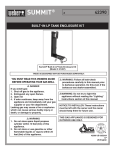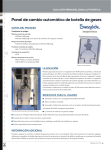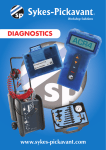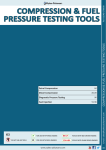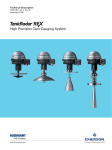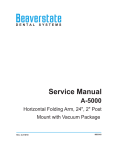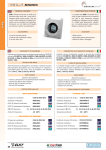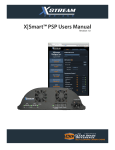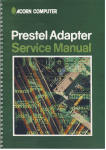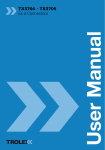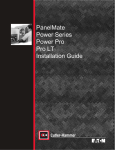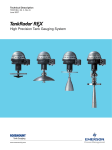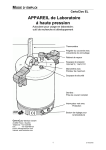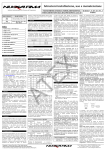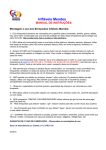Download THE XHR-300 SERIES
Transcript
THE XHR-300 SERIES Operating and Service Manual Series includes all variants of XHR-300/301/310/311 Issue B September 2015 1 TABLE OF CONTENTS 1. Description ............................................................................................................................. 3 2. Installation and Wiring ........................................................................................................... 4 2.1 Enclosure (Junction Box) .......................................................................................... 4 2.2 Regulator.................................................................................................................. 4 2.3 Mounting ................................................................................................................. 4 2.4 Wiring Instructions .................................................................................................. 4 3. Operation ............................................................................................................................... 5 3.1 Adjusting the Regulator ........................................................................................... 5 3.2 Adjusting the Temperature...................................................................................... 5 4. Special Conditions for Safe Use ............................................................................................. 6 5. Hazardous Location Usage ..................................................................................................... 6 5.1 Marking .................................................................................................................... 6 6. Servicing and Maintenance .................................................................................................... 7 6.1. Servicing the XHR-300............................................................................................. 8 6.1.1. Accessing the Main Valve Assembly ........................................................ 8 6.1.2. Adjusting the Set Point ............................................................................ 9 6.1.3. Figure 1 – Sectional View of the XHR-300 ............................................. 10 6.2. Servicing the XHR-311........................................................................................... 11 6.2.1. Accessing the Main Valve Assembly ...................................................... 11 6.2.3. Figure 2 – Sectional View of the XHR-311 ............................................. 12 7. Technical Data ...................................................................................................................... 13 8. Warranty Statement ............................................................................................................ 13 2 1. Description The XHR-300 series comprises of the following models: - XHR-300 – Dual heated, diaphragm sensed pressure regulator (standard option) XHR-310 – Dual heated, diaphragm sensed pressure regulator (disk seat option) XHR-301 – Dual heated, piston sensed regulator (standard option) XHR-311 – Dual heated, piston sensed regulator (disk seat option) The maximum working pressures for each model are defined in the table below and are determined both by the model and the seat material. The maximum outlet control range of the diaphragm sensed and piston sensed options are 0-35 bar and 0-150 bar respectively. Model Seat Material PCTFE PEEK XHR-300 210 bar 300 bar XHR-310 300 bar 414 bar XHR-301 210 bar 300 bar XHR-311 300 bar 414 bar Regulator housings are machined from 316 SS (stainless steel). This ensures maximum protection against the media on which they will be used and the environment in which they will be placed. The regulator can be used to regulate any gas or liquid that is compatible with the materials of construction. The electronics controlling the heat input to the regulator/manifold are installed within a Cortem GUB flameproof enclosure. The electrical housing is of Aluminium Alloy construction, with mounting lugs to provide a secure connection to the panel. The user must ensure that media in contact with the regulator is compatible with these materials. The enclosure has three cable entries of size M20 x 1.5 through which the electrical supply can be made (ref. ‘Wiring Instructions’). The remaining entries must be sealed with ATEX approved Blanking Plugs (supplied). The models are fitted with two heat exchanging sheaths each enclosing a 100W cartridge heater within. The media passes over the sheath on the inlet to the regulator for ‘pre-heat’, and after the pressure reduction within the regulator, then passes the second sheath on the outlet for ‘secondary heat’. An adjustable pot within the electronics controls the amount of heat output via a burst-firing controller within the circuit board. Each heater cartridge has an independent switch which can be used to isolate the power to either channel. The cartridges are wired independently and fitted with type J sensors, which monitor the temperature to each unit separately and keep the regulator within its T3 temperature class. The XHR-300 series should not be exposed to any vibrations or impacts, and should be securely fastened in accordance to the Installation Instructions below, and should be limited to the vibration limits stated in the Section 7, Technical Data. Any pressure gauges used on the regulator must be designed as ‘Full Safety Pattern’ to BS1780, ANSI B40-1 and EN837-1. 3 2. Installation and Wiring Before installation, check the nameplate (where applicable), model number reference and regulator label affixed to the enclosure and ensure that the voltage type and pressure range complies with the installation requirements. *Note: Installation of the XHR-300 series of heated regulators should be in accordance with EN 60079-14 2.1 Enclosure (Junction Box) The enclosure is of series GUB manufactured by Cortem. The enclosure is marked Ex II 2 Gb / Ex d IIC Gb (equipment group II, cat 2) in accordance with certificate CESI 01 ATEX 034U and IECEx CES 14.0012U. The enclosure has an ingress protection level IP 66. 2.2 Regulator The pressure regulator is supplied with 1/4” NPT connections for both the inlet and outlet ports. Connections for gauges are available and will be 1/4” NPT as standard. The maximum supply pressure to the regulator should not exceed the maximum pressure indicated on the regulator label. The pipe work and gauges should be sealed with the regulator using PTFE tape. *Note: Pressure Tech do not recommend sealant compound for pipe work connections. 2.3 Mounting The whole assembly should be securely fastened to a back plate or panel using the corner holes in the junction box. For added support, the top of the regulator can be panel mounted around the bonnet, using the optional panel nut (PT C 024). *Note: The panel nut alone should not support the regulator, i.e. with the box left freestanding. 2.4 Wiring Instructions Ensure that no electrical power is supplied during maintenance, installation or servicing this product. The power supply to the junction box will require a certified cable gland to be used. An external earth point is located on the enclosure. CAUTION: Refer to accompanying documents There are three cable gland entries on the enclosure, each connection is M20 x 1.5 – 6H Use cable and cable entry devices suitable for 77°C Feed the supply cable through the cable gland (not supplied) and secure the wires to the terminal block ensuring the Live and Neutral are correctly orientated (ref. Drawing No. PT-XHR-300-CIR-002) *Note: Wiring should be made in accordance with BS7671 ‘Requirements for electrical installations’. 4 3. Operation 3.1 Adjusting the Regulator For the XHR-300 series of regulators, turning the hand wheel clockwise compresses the spring, which in turn opens the main valve and allows the inlet pressure to pass through the orifice until the outlet pressure is equivalent to the loading forces set by the compressed spring. 3.2 Adjusting the Temperature An adjustable potentiometer on the surface of the PCB controls the amount of heat output via a burst firing controller. The cartridge is fitted with a type J sensor which monitors the temperature to the unit. Should this sensor fail, or the wiring becomes disconnected, the PCB will not apply power to the heater cartridge. The adjustable pot is factory pre-set to its midpoint, but may need adjusting to increase or decrease the heat requirements to the regulator. *This adjustment must be made when there is no risk of explosion from the outside environment. To adjust the setting: i. ii. iii. iv. v. 5 Loosen the M4 grub screw and open the cover of the junction box. Change the heater output by turning the pot on the circuit board clockwise to increase, and anti-clockwise to decrease. Due to the response time of heat transfer and thermal coefficients, the control system will require about 5 to 10 minutes to stabilise. Therefore, it is recommended that the heater is switched on before allowing the media to pass through the regulator. The following percentage turns around the potentiometer equate to an approximate temperature value for the heater cartridges: 10% – 20°C 25% – 60°C 50% – 100°C 75% – 140°C 100% – 180°C When the correct temperature setting is made, screw back the box cover and secure grub screw. 4. Special Conditions for Safe Use On non-venting regulators with pressure on the outlet, the hand wheel shall not be turned anti-clockwise, in this case, pressure shall be reduced by venting downstream of the regulator and turning the hand wheel simultaneously anti-clockwise. The junction box should never be opened whilst there is a flammable gas atmosphere present, or when there is a risk of explosion from the outside environment. The user shall ensure that the equipment is appropriately connected to earth. The equipment shall not be exposed to vibrations exceeding 5m/sec2 The equipment shall be protected from mechanical impact in service by location or suitable guarding. To prevent damage being caused to the regulator, which may result in an ignition risk, it is the user’s responsibility to ensure the equipment is operated in accordance with the manufacturer’s instructions and recommendations. The equipment has flame paths which differ from those in IEC 60079-1:2014. The manufacturer, Pressure Tech, shall be contacted for guidance when maintaining the flame paths. 5. Hazardous Location Usage The XHR-300 series of regulators have been certified under the ATEX directive 94/9/EC as suitable for use in Group II, Category 2 gas environments, where the surface temperature does not exceed 200°C (based on ambient temperature conditions of -40°C to +60°C) and is flameproof to EN 60079-0 and EN 60079-1. 5.1 Marking The marking of the equipment shall include the following: Ex II 2 G T3 Ex db IIC GB T3 Ta = -40°C to +60°C 6 6. Servicing and Maintenance The XHR series comprises of both diaphragm and piston sensed options for pressure control. Each can be fitted with one of two options of main valve assembly (MVA). The combinations of such result in the four models of heated regulator described in section 1. Two examples of which are used in this section with an intent of covering most options available. Servicing and maintenance work on the XHR-300 series should only be performed after fully reading and understanding the Operating and Servicing Manual. Due to the typical nature of the gases the regulator will be used on, the operator should not endanger himself/herself or others by working on this regulator without prior knowledge on the Health and Safety concerns relating to handling of technical gases. Any uncertainty should be clarified with Pressure Tech before working on the regulator. Repairs to the regulator should be performed in accordance with BS EN 60079-17 and BS EN 60079-19 as applicable. Pressure Tech Ltd recommends the use of Krytox GPL 205 during servicing. IMPORTANT: Any failure within the electronics should result in the unit being returned to Pressure Tech for evaluation and repair. Prior to commencing service, please ensure that: - 7 The equipment has been de-pressurised The load spring has been de-compressed by turning the hand wheel / adjusting screw fully anti-clockwise Applications involving toxic, flammable or corrosive media have been fully purged 6.1. Servicing the XHR-300 *Note: fig 1 should be used as a reference for the following set of instructions 6.1.1. Accessing the Main Valve Assembly To access the Main Valve Assembly (MVA): i. ii. iii. iv. v. vi. vii. viii. ix. x. xi. Secure the regulator body (3) in a vice* and loosen the Bonnet (15) from the regulator body using a 47mm open ended torque wrench or equivalent ensuring that the Hand Wheel (3) is fully wound anti clock wise (NOTE*) *Where this is not possible it may be necessary to secure the enclosure. If the lid of the enclosure is to be removed it is important to ensure that an explosive atmosphere is not present before doing so. Remove the Upper Spring Rest (11), 10mm Ball Bearing (9), Load Spring (20), Diaphragm Washer (19), Lower Spring Rest (12) and Diaphragm (10) from the assembly The Seat Nut (6) can then be removed using a 12mm socket Remove the Main Valve (4, 5) and Main Valve Spring (7) from the assembly Visually inspect the seat nut (6) and soft seat (5) for damage under a microscope Replace the Main Valve Spring (7) and Main Valve (4, 5) and place into the Regulator Body (3) Replace Seat Nut (6) fitted with new 5x1 mm O-ring (8) taking care not to damage the sealing face against the tip of the valve To ensure positive sealing, it is recommended that a new Diaphragm (10) is placed centrally into Regulator Body (3) ensuring that the outermost convolutions are facing towards the Bonnet (15) Replace the 21x1 mm O-ring (21) on the Lower Spring Rest (12), insert into the Diaphragm Washer (19) and place on top of the Diaphragm (10) Place the Load Spring (20), Upper Spring Rest (11) and 10mm Ball Bearing (9) to the assembly Screw the Bonnet (15) onto the assembly and using a torque wrench with a 47mm open ended attachment, tighten to 160Nm It is recommended that all parts in the repair kits are used. Any defect parts removed during the service should be disposed of. Parts should be kept clean in line with media requirements. Following re-assembly of the regulator, pressure tests should be made to both the inlet and outlet side of the regulator, to ensure there is no internal or external leakage across the regulator. To ensure that the main valve assembly has been correctly and effectively installed it may be required to perform the appropriate seat leak test as per ANSI/FCI 70-2. Should any assistance be required during a service please do not hesitate to contact the office. 8 (NOTE*) It is not recommended (or necessary) to remove the Hand Wheel (18) during service as this will affect the set point of the regulator. Should it be required to adjust the set point please follow the instructions below: 6.1.2. Adjusting the Set Point To adjust the set point: i. ii. iii. iv. v. vi. vii. viii. ix. x. xi. xii. xiii. xiv. xv. xvi. 9 Remove the Nameplate (17) and Cap (16) from the Hand Wheel (18) and loosen the Lock Nut (14) such that the Hand Wheel is able to spin freely on the Adjusting Screw (13) Connect the correct fittings to the Inlet and Outlet ports of the regulator. Ensure that any gauge ports are plugged or that the correct gauge is fitted With the Regulator Body (3) securely fixed to the Heater Sheaths (5) apply the Maximum Working Pressure (MWP) to the Inlet of the regulator Connect the Outlet port to a calibrated pressure test gauge appropriate to the required set pressure. As the regulator is non-venting, ensure that a ball/needle valve is fitted to allow pressure to be relieved downstream of the regulator Using a slotted screwdriver, turn the Adjusting Screw (13) clockwise until the desired set point has been reached Ensure repeatability by allowing flow through the regulator using the ball/needle valve With the outlet pressure set, screw the first Lock Nut (14) to the base of the Adjusting Screw (13) against the Bonnet (15) Position the Hand Wheel (18) onto the Lock Nut (14). Ensure that the Lock Nut and Hand Wheel become engaged Fasten the second Lock Nut (14) against the Hand Wheel (18) and gently begin to tighten using a 13mm socket until it begins to secure itself At this point, whilst holding the Hand Wheel (18) continue to tighten whilst simultaneously turning slightly anti-clockwise to prevent it from locking against the Bonnet (15) Ensure that the Lock Nut (14) is sufficiently tightened, taking care not to adjust the set point Turning of the Hand Wheel (18) should now also turn the Adjusting Screw (13) which will control the pressure Turn the Hand Wheel (18) clockwise until it reaches its set point and check to make sure that the desired outlet pressure is correct. If the set point is not correct, repeat steps v. to xiii. Reduce the pressure downstream by venting the pressure through ball/needle valve and then turning the Hand Wheel (18) anti-clockwise until the regulator closes The Cap (16) and Nameplate (17) can now be placed into the Hand Wheel (18). Ensure that the information stated on the Nameplate (17) is in accordance with the set pressure of the regulator 6.1.3. Figure 1 – Sectional View of the XHR-300 (172.6) (111.1) Ø40 65 Ø60 Ø49 M33x1 - 6g (116) A 58 11 Ø52 A 1 23 55 (50.28) ITEM 1 2 3 4 5 6 7 8 9 10 11 12 13 14 15 16 17 18 19 20 21 22 120 DETAIL C SCALE 3 : 1 6 8 5 4 7 C 17 16 18 13 14 15 9 11 20 12 21 23 PARTS LIST PART NUMBER DESCRIPTION PT-EHR-300-006 CORTEM BOX PT-EHR-300-005-230 HEATER CARTRIDGE 230V PT-EHR-300-N-SS BODY - N PORTING - 1/4" NPT PT-C-001-013 MAIN VALVE WITH SQUARE PT-C-002-011 PCTFE SEAT PT-C-007-002 SEAT Cv 0.06 PT-C-006-002 MAIN VALVE COMPRESSION SPRING OR-0050-10 O' RING STD BALL-010-SS-316 10MM BALL BEARING PT-C-010-002 DIAPHRAGM PT-C-017 UPPER SPRING REST PT-C-018-002 BOTTOM SPRING REST PT-C-019-003 ADJUSTING SCREW PT-C-020 LOCKNUTS PT-C-015 BONNET NAMEPLATE CAP FIT-CAP-4343092 NAMEPLATE PT-C-022 PT-C-021 SMALL HANDWHEEL PT-C-016 DIAPHRAGM WASHER PT-C-011-009 LOAD SPRING OR-0210-10 O' RING STD FIT-03-08-BSP-BOND-SEAL 3/8" BSP BONDED SEAL 19 10 3 SECTION A-A SCALE 1.5 : 1 5 2 3 22 © Copyright of Pressure Tech Ltd 10 6.2. Servicing the XHR-311 *Note: fig 2 should be used as a reference for the following set of instructions 6.2.1. Accessing the Main Valve Assembly To access the Main Valve Assembly (MVA): i. ii. iii. iv. v. vi. vii. viii. ix. x. xi. xii. xiii. xiv. Secure the regulator body (5) in a vice* and using a 47mm open ended torque wrench or equivalent loosen and remove the Bonnet (21) from the Regulator Body *Where this is not possible it may be necessary to secure the enclosure. If the lid of the enclosure is to be removed it is important to ensure that an explosive atmosphere is not present before doing so. Remove the Upper Spring Rest (24), 10mm Ball Bearing (25) and Load Spring (20) from the assembly Lift the Lower Spring Rest (11) out of the assembly and then remove the sensor assembly comprising of Sensor (14) and Sensor Holder (13) from the Body (5) Using a 12mm socket, remove the Seat Retainer (6) and O-Ring (10) from the Regulator Body (5) Grip the main valve (7) (needle nose pliers may be useful) and lift out of the Body (5) which will in turn bring out the Soft Seat Disk (8) and O-Ring (9) The Main Valve Spring (11) can then be removed and replaced if required Place new Main Valve (7) on to the Main valve Spring (11) The Soft Seat Disk (8) can then be positioned into the Body (5) ensuring that the ORing groove is facing outwards then carefully position the O-Ring (9) into place (care should be taken when positioning the seat disk over the main valve) Replace the O-Ring (10) on the Seat Retainer (6) and screw the Seat Retainer into the Body (5) and tighten with a 12mm socket Replace the O-Ring (16) and Back Up ring (18) on the Sensor Holder (137) and replace the O-Ring (15) and Back Up Rings (17) on the Sensor (19) - (*29 and *30 for smaller 8mm sensor *28) Place the Sensor (14) into the Sensor Holder (13) and position the assembly into the Regulator Body (5) Replace the O-Ring (19) on the Lower Spring Rest (12) and position into the Sensor Holder (13) Place the Load Spring (20), Upper Spring Rest (24) and 10mm Ball Bearing (25) to the assembly and screw the bonnet (21) into position Finally tighten the bonnet to 90 Nm with a 47mm open ended torque wrench To ensure that the main valve assembly has been correctly and effectively installed it may be required to perform the appropriate seat leak test as per ANSI/FCI 70-2. 11 6.2.3. Figure 2 – Sectional View of the XHR-311 (161.13) 28* Ø40 M33x1 - 6g 27* 67 Ø60 Ø50.5 (123.2) 30* A * ALTERNATE 8mm SENSOR ASSEMBLY VIEW (2:1) 58 11 A (116) 29* 2 PARTS LIST 23 (50.28) 23 55 120 DETAIL B SCALE 3 : 1 6 10 7 8 9 SECTION A-A SCALE 1.5 : 1 11 B 23 22 25 24 20 21 12 19 14 13 17 18 15 5 1 4 3 26 ITEM 1 2 3 4 5 6 7 8 9 10 11 12 13 14 15 16 17 18 19 20 21 22 23 24 25 26 27* 28* 29* 30* PART NUMBER PT-EHR-300-001 PT-EHR-300-006 PT-EHR-300-007 PT-EHR-300-005-230 PT-EHR-301-N-SS-001 PT-C-007-015 PT-C-001-023 PT-C-205-003 OR-0060-10 OR-0090-10 PT-C-006-002 PT-C-018-006 PT-C-137 PT-C-138 OR-0080-20 OR-0190-20 PT-C-092-001 PT-C-176 OR-1071-16 PT-C-011-003 PT-C-015 PT-C-020 PT-C-062 PT-C-017 BALL-010-SS-316 FIT-03-08-BSP-BOND-SEAL PT-C-105-001 PT-C-106 OR-BS008 PT-C-104 DESCRIPTION HEATER CARTRIDGE SHEATH CORTEM BOX CONNECTION FITTING HEATER CARTRIDGE 230V BODY - N PORTING - 1/4" NPT - SOLID DISC SEAT RETAINER MAIN VALVE - SOLID TYPE PEEK SEAT O' RING STD O' RING STD MAIN VALVE COMPRESSION SPRING LOWER SPRING REST 12MM SENSOR HOLDER 12MM SENSOR O' RING STD O' RING STD PTFE BACK UP RING PTFE BACK UP RING O' RING STD LOAD SPRING BONNET LOCKNUTS ADJUSTING SCREW UPPER SPRING REST 10MM BALL BEARING 3/8" BSP BONDED SEAL 8mm SENSOR HOLDER 8mm SENSOR O' RING STD PTFE BACK UP RING *ALTERNATE PARTS © Copyright of Pressure Tech Ltd 12 7. Technical Data Vibration Limits: Can be used where vibration limits do not exceed 5m/s Electronics: 115Vac or 230Vac (+/- 15% at 50Hz or 60Hz), 3 Amps 1.5VA Supply Power 200W Power Load (2 x 100W) Heater: Proportional type J thermocouple with automatic CJC Temp control range: 0 - 180°C Temp control accuracy: +/- 1% Temp repeatability: +/- 0.5% Fluid Media: All gases and liquids compatible with materials of construction Max Inlet Pressure: XHR-300/301: 300 bar (PEEK) or 210 bar (PCTFE) XHR-310/311: 414 bar (PEEK) or 300 bar (PCTFE) Outlet Pressure Range: 0-35 bar (Diaphragm), 0-150 bar (Piston) Operating Temperature: -40°C to +60°C Materials: Body and Trim: 316 SS Diaphragm: Inconel X750 Seat: PCTFE or PEEK® Enlosure: Epoxy coated Aluminium Flow Capacity (Cv): 0.03 / 0.06 / 0.1 / 0.2 Leakage: Liquid: Zero drops of water at max inlet Gas: Bubble tight 8. Warranty Statement Pressure Tech Ltd guarantee all products correspond with their specification at the time of delivery and, with exception to wear and tear, wilful damage, negligence, and abnormal working conditions, will be free from defects for a period of 12 months from date of delivery. 13













